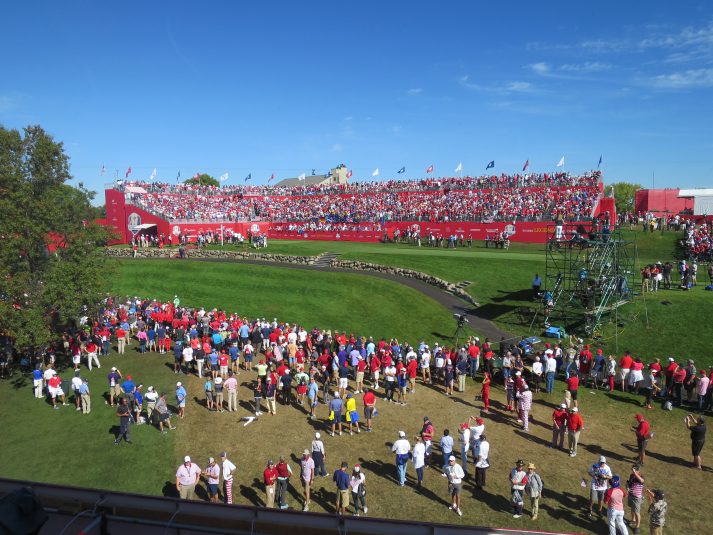Live From the Ryder Cup: Sky Sports Makes Most of Augmented Reality and NEP, Telegenic Facilities
Story Highlights
Sky Sports UK is onsite at the Ryder Cup and relying heavily on the world feed produced by European Tour Productions (ETP) and also calling NEP ND6 home for the week. But the production team is also making the most of Sky’s own facilities, most notably the impressive studio set used at the Open Championship across the pond in July and making the most of Telegenic’s T4 and T5 production trailers that have been at the center of U.S. golf coverage this season.
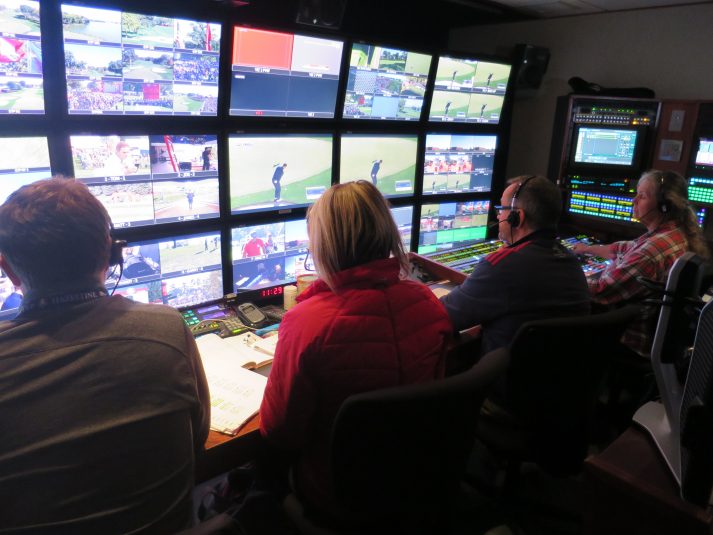
The Sky Sports team is working out of NEP’s ND6 for the Ryder Cup.
“ETP has host coverage that we can rely on,” says James Clement, head of operations, Sky Sports. Sky’s studio operations make use of three cameras plus a fourth on a Jimmy Jib, and on-course coverage includes two unilateral RF cameras as well as an iMovix HiMo RF camera and two handheld cameras that can be hooked up to cable drops at the first tee, 18th green, and other locations.
David Culmer, production manager, Sky Sports, adds that another key this year is the use of Level 3 circuits between Chaska, MN, and the Sky Sports production facility in the UK. The Level 3 circuits give the Sky Sports team 450 Mbps of outbound connectivity across the pond and the ability to send three video feeds encoded using Nimbra J2K encoders to the UK and feeds encoded as H.264 streams to return to Hazeltine golf course. IP-based communication systems are also riding on the Level 3 circuits, allowing seamless communication. Sky Sports News can even control the prompters from the UK by building 160 ms of latency into the system.
“The NCAM system is also interesting,” says Culmer of the camera system that allows Vizrt augmented-reality graphics of the Ryder Cup players to be integrated into live shots out of the studio, giving the appearance that the players magically appeared in the studio. As for the previous Ryder Cup, the production team on location shot video of the players and then was able to send the files, each about 4 GB in size, to the UK via File Catalyst for final post. About 200 GB of files was returned to Minnesota for use by the studio-production team.
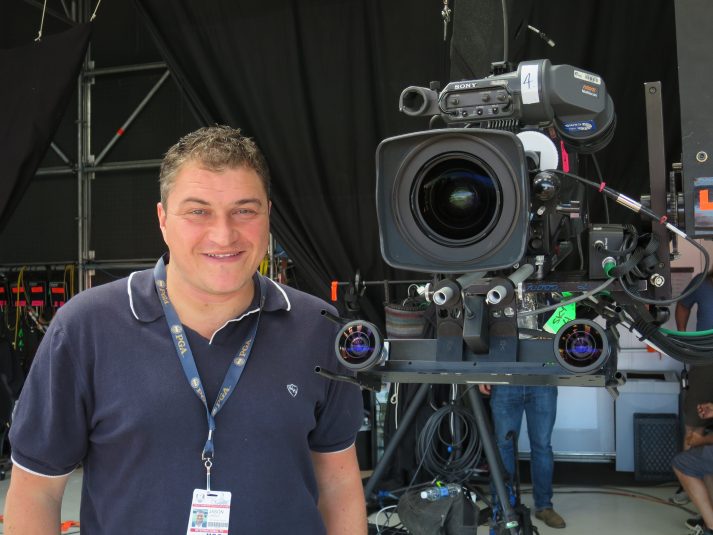
Jason Landau, design director, Sky Sports, with the NCAM system in the Sky Sports Studio
The NCAM system is attached to a Sony camera in the studio and allows augmented-reality graphics created with the Viz graphics engine (in this case, video avatars of players and captains) to be placed in the studio alongside the talent. Another change since the Open is that Sky Sports now owns the NCAM system that allows augmented-reality graphics to be brought to the studio.
“There was a good case for buying it after it was successfully used at the Open,” explains Jason Landau, design director, Sky Sports.“By owning it, we give our guys the opportunity to learn more about it.”
Earlier in the week, the Sky production team had 15 minutes with each player and captain and was able to shoot video of individual players and captains taking a couple of steps forward and folding their arms or stepping forward and doing something like pulling out a yardage book or putting on a golf glove.
“It brings a bit of life to our coverage, so that, when there is a discussion about a player, their image isn’t frozen,” says Landau. “We also put in shadows this time, which really helps.”
Sky Creative’s Phil Madge was lead Viz specialist on this, and Dom Hudson, of Sky’s graphics and data team, was lead technical specialist.
“The director for the Ryder Cup, Mike Allen, was, of course, involved, working with the cameramen to ensure the visualization was as strong as it could be,” adds Landau.
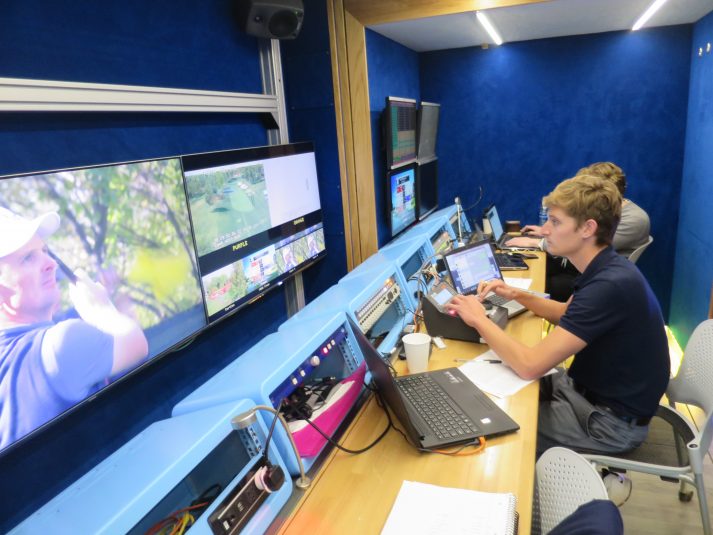
Telegenic’s T5 unit is used at the Ryder Cup for commentary, as a green room, and for Hego control of the studio touchscreen monitor.
Many of the production trailers onsite at the Ryder Cup are similar in form and function. The exception? Telegenic’s T5 trailer, an expandable OB unit that Sky Sports commissioned earlier this year for use on all of Sky Sports golf coverage in the U.S. With T5 in the compound, the Sky Sports production team has a mobile unit that can handle a wide variety of production functions depending on the level of golf tournament being produced.
“We looked at the cost of having something proper like T5 versus using trailers about 18 months ago and have now been using it for six months,” says Clement. “This allows for simpler setup, and the talent can be in a nice environment for a week.”
The T5 expandable production trailer houses a commentary cabin, a large and comfortable green-room area for talent, a DiGiCo audio console, and a small front-bench area used to manage the Hego with Perfect Parallel for the studio touchscreen monitor used by talent for analysis. An EVS XT3 server is on hand to record clips to be used during analysis, Grass Valley Edius is on hand for editing, and a Blackmagic Videohub provides vision-mixing support. The unit features equipment racks behind soundproof glass to create a quiet environment and also separate temperature-control zones to create a comfortable environment.
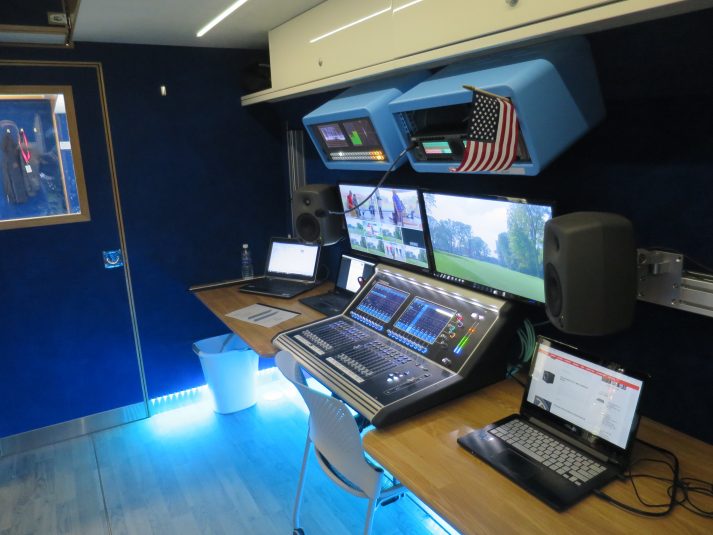
The DiGiCo console inside the T5 trailer
“On the lower-level golf events,” says Clement, “the director and EP can cut a two-camera shoot of the touchscreen, and then that feed can go back to London as a separate unilateral from the world feed and then cut into that feed. So it’s kind of like a mini remote-production facility.”
At top-level events, such as the Ryder Cup and U.S. major tournaments, the T5 unit serves as the integration point for Hego, a top-notch green room for on-air talent as well as the commentary studio. Previously, Sky Sports would rent the typical portable office trailers and basically have to start from scratch for every event.
“The T5 unit can be deployed by one person in about 20 minutes,” says Andrew Wisniewski, who oversees the unit for Telegenic. “Sky wanted to create the best possible facility to combine hospitality, a good commentary area, and all of the related equipment in one unit. You can also have different temperatures in different rooms, and the rooms are very quiet when you close the doors.”
The T5 unit is complemented by T4, which is a nondescript green shipping container on the outside but inside has technical firepower for four Grass Valley Edius editing suites, featuring After Effects that can access 120 TB of onsite storage of previous golf events, and also provides quiet operation, thanks again to machine racks located behind glass doors.
At the Ryder Cup, the production team in T4 is working on show opens and three edit suites for features; the nature of the Ryder Cup makes it a very feature-rich environment.
“Also, certain walls can move to create different work spaces, like a meeting room,” says Wisniewski. “You can also have different temperatures in different rooms and the rooms are very quiet when you close the doors.”
Sky Sports Studio Makes Trip
Sky Sports also leveraged the on-course studio built for the Open Championship, held in July at Royal Troon in Scotland.
“It worked so well at the Open, so it made sense to bring it here as well,” Landau explains. “And we’ve gone for the vista of the first tee because the Ryder Cup is all about excitement and, from our location, you can hear and see the buildup to the event as it happens. It’s a great place to be and a party atmosphere.”
The big change in the studio is that the 65-in, touchscreen used at Royal Troon for the Open has been replaced with a smaller, 55-in. touchscreen.
“At the Open, we found that the screen we had was fighting against the sun and, not surprisingly, it lost,” explains Landau. “So, this time, we have a smaller screen in place, but it has up to 7,000 nits of brightness compared to 3,000 nits for the larger screen.”
